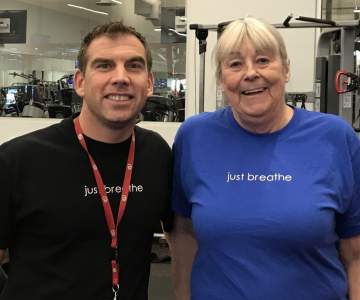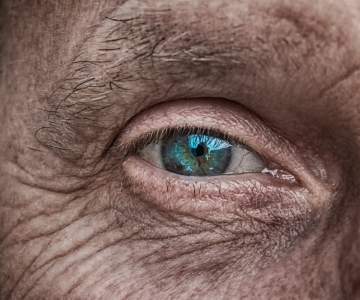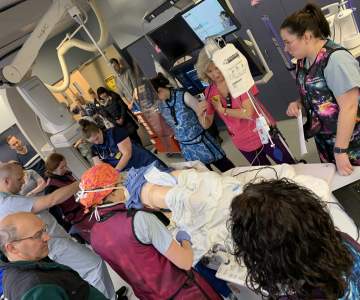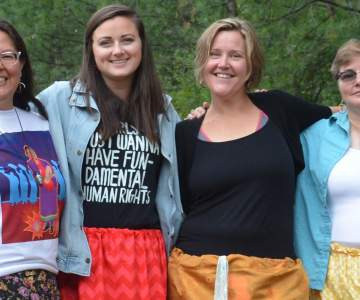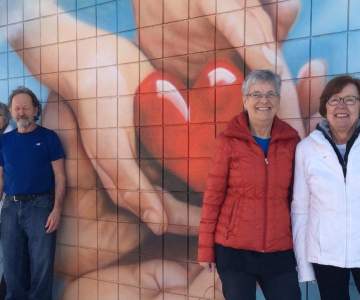Breadcrumb
Explore Stories
5 Minute Read
Health & Wellness
A psychiatrist who has worked with challenging patients for 17 years without one violent incident might be excused for forgetting all safety protocols when a teenage patient suddenly attacked him.
Dr. Michael Ocana learned many lessons that day, six months ago, and he has been sharing them with his colleagues in hopes of helping them avoid the potential negative consequences of such an event. He also hopes to help them avoid a similar situation.
Dr. Ocana has experience with trauma specific therapies, which gave him the opportunity to put theory into practice on himself.
Violence in the workplace is not uncommon for health-care professionals. Security protocols and equipment are in place to keep people safe, but sometimes the unexpected happens.
For Dr. Ocana, his automatic response was to act as though nothing much had happened. Initially, he didn’t talk to anyone, not the staff on the floor, not his colleagues, not his wife.
As he reflects back now, he wonders if he felt embarrassed that he didn’t predict his patient’s behaviour. He admits he felt shame for not pushing the Code White button or immediately telling clinicians on the floor about the assault.
As he began relating the story to physicians at a recent leadership conference, Dr. Ocana appeared relaxed, but then, abruptly drawing in his breath, he said, “Whoa, here we go.”
It’s still not easy for him to go back in time to that day.
The youth he was treating was psychotic when he first came to hospital. He had glaring eyes and spit aggressively when approached. He couldn’t speak in a coherent sentence. As time went on, though, therapy and medication began to work.
When Dr. Ocana returned after a vacation, the team in charge of the teenager’s care told him how well he was doing. The youth appeared relaxed and approachable. He didn’t hesitate to ask the youth to come into his office for a one-to-one catch-up on the past couple of weeks.
“He responded fluidly to my questions. His words made sense. Hearing him talk in complete sentences was reassuring that he was making good progress.”
But then the conversation turned heated when they disagreed over medication options.
“He looked up and the next I knew, he was moving through space toward me. It’s all a blur. All I know is my arm must have come up. I saw my pen broken on the ground. I think I yelled. I don’t know what he yelled and then he was back in the chair.”
I asked him, “what the hell was that?” and he answered, “I’m frustrated.”
Taking a break from his story, Dr. Ocana told the room: “This would have been a good time to push the button,” referring to the Code White alarm on his desk. He didn’t. It didn’t cross his mind. Instead, he started to walk the youth back to the unit, regardless of the fact they had to pass through a locked space between two double doors.
“I should have called for security. I had to go around him to get to the door.”
As Dr. Ocana walked by him, the teenager hit him across the face with a backhanded swing.
“What stands out in my mind even now is the expression of pure rage on his face.”
He managed to swipe the door and send the young man back into the unit.
“It wasn’t a good decision to send a kid who’d just acted violently back into a room full of other kids. I didn’t think of that. I didn’t think to give the staff a heads up. I just walked back to my office, sat down and looked out the window.”
“When I went back into the unit, there he was chatting to the nurse with no sign of anger. I walked into the nurses’ station and said I’d been assaulted. Then I had to file an incident report.”
As he thinks back now, he knows he was basically in shock for the rest of the day.
“Your ability to function is impaired, but it’s amazing what you can do on autopilot.”
No one realized he was in emotional trouble since he told no one and as a result, no one reached out to him.
“I was the leader of the unit. I felt responsible. A person naturally wants to rise to that opportunity. In our roles, we want to fix things and the idea we might be vulnerable and need help is quite foreign. It’s part of our culture – it’s difficult to ask for help.”
When they learned about the incident, many people did say, “I’m sorry that happened. If you need help, give me a call.” But it wasn’t until his nurse educator asked how he was doing that he admitted. “I’m pretty shaken up right now.”
He remains grateful to her for her response.
“She pulled up a chair and told me about her own experience and how it affected her.”
That vulnerability gave him permission to start talking to people. He talked to his wife, he told his friends and colleagues and little by little he felt himself able to process what had happened.
“The neurochemistry of shame is to disconnect and avoid being noticed.”
As well as speaking to colleagues with expertise in trauma, Dr. Ocana scaled back his work a little, but he didn’t isolate himself to home.
“I took it easy on myself and by talking to some people, I got back to myself. In fact my practice and personal life has never been better, which is nice to be able to say!”
He is more aware today of the importance of creating a culture of health and safety in the workplace. He said since that day when he stared violence in the face, he has carried the alarm and is prepared to use it.
“I’ve had two false alarms where I pushed it accidentally, but everyone came. It worked and that was a relief.”
Dr. Harsh Hundal, left, joined Dr. Michael Ocana, a psychiatrist, in a conversation on physician safety at a recent Interior Health physician leadership session.
3 Minute Read
Health & Wellness
It’s Valentine’s Day and Cupid’s arrow will strike far and wide. So let’s take advantage of this love-themed month to debunk a few myths about sex and older adults.
Sexual feelings do not disappear as you age
There are many taboos around sex and older adults. One such myth is that older people should not, cannot, or would not want to have sex.
“I typically get lots of questions about sex from clients at my clinics,” says Mary Kjorven, a nurse specialist in gerontology and nurse continence advisor at Interior Health. “Many older adults find it difficult to talk about sex because they feel there is a stigma about having sex at an older age. Their families, who might prefer to think of mom or dad as asexual, often perpetuate this belief. But sex and sexuality is really important to quality of life as you get older.”
Sexual experiences and how we express sexuality changes.
“As with all stages of life, personal relationships, experiencing joy in life and being present in the moment are very important to older adults,” says Shannon Paul-Jost, a clinical nurse specialist in gerontology. “Sex is a way to affirm these feelings. As people age, the frequency or ability to perform sex may modestly decline, due to physical abilities such as erectile dysfunction or vaginal dryness; however, the majority of older adults are enthusiastic about sex and intimacy.”
When Frank and Kathy’s kids left home, the couple discovered a whole new intimacy in their relationship – a side that had been somewhat restricted when teenagers were wandering the house at night.
“People assume older adults don’t have sexual desires. That’s just not true. In fact, it’s essential to revive or continue physical intimacy in our so-called golden years,” says Kathy, with a wink at her husband.
Illness, medication and health conditions can play a role in changing life in the bedroom.
A person’s health, as opposed to their age, can affect sexual ability and experience.
Poor health or chronic health conditions, such as heart disease or arthritis, make sex and intimacy more challenging. Certain surgeries and many medications, such as blood pressure medications, antihistamines, antidepressants and acid-blocking drugs, can also affect sexual function.
“Many older people feel embarrassed about asking their health-care provider about sex,” says Shannon. “They might feel unsure about the reaction to their questions, or worry there isn’t enough time in their appointment.”
While certain health conditions can affect desire and sexual ability, many people still want and need intimacy, and continue to have sexual desires as they grow older. “Often all that’s required is a little more creativity,” says Shannon. “Minor adjustments, such as taking more time, trying a different position or using props may be required to ensure sexual experiences continue to be fulfilling and satisfying.”
”Our decision to honour and protect our sex life is one reason we have such a close relationship even in our 70s,” says Kathy.
4 Minute Read
Health & Wellness
While Merle Crawford was in palliative care at Royal Inland Hospital (RIH), the former pediatric nurse did her best to remain bright and cheerful.
But there were days when it was a struggle; times when she
needed someone to cheer her up.
Enter Saylor the therapy dog.
Saylor brought a bright smile to Merle’s face, and to her
family’s, when he appeared in the room.
“The day Saylor went up to her bed, and she was able to pet
him, brought her such joy,” says Merle’s daughter Cathie. “As we watched her
face light up, our family could only say…thank-you Saylor.”
Visits like that are old hat for Saylor the therapy dog since
joining the St. John’s Ambulance team of about 60 therapy dogs in Kamloops.
Saylor and his brother Tenor have helped many patients through tough times, visiting
with young and old when they work at RIH.
Arriving at the hospital on one of their typical visits, the
two pure-bred poodles begin their day with a trip down RIH’s main hallway, along
with their handlers, brothers Don and Greg Garrish. They touch many lives along
the way, greeting people in the hallways and travelling to various units
including pediatrics, psychiatry, physiotherapy, cardiac care and orthopedics,
to name just a few.
One of Saylor’s favourite places is the stroke and rehab
clinic.
“He enjoys spending
time with people who are relearning how to walk and talk, and sometimes snuggles
with a patient he has been visiting for a number of weeks,” says Don. “The
rehab unit even keeps an extra dog leash on hand so patients can help walk
Saylor around the floor.”
Saylor and Tenor make
special visits to intensive care and also receive other special requests for
visits.
Unfortunately, the
dogs can’t be at the hospital every day. But now, with some innovative
thinking, Saylor’s soothing skills are available even when he’s not able
to physically be there thanks to “nurse call” technology that allows quick
voice calls between caregivers.
If a patient is in distress and a therapy dog can help, the
nurse can simply press a button and say ‘call Saylor the hospital therapy dog’
and the patient will hear a series of pre-recorded barks along with a message
wishing them well.
The idea came to Saylor’s handler Don one day at the
hospital as he was visiting pediatrics. A staff member approached Don and said she
wished Saylor could have been there the previous night to help with a patient.
Familiar with the nurse-call technology from his volunteer
work in intensive care and with the patient and family advisory council, a
lightbulb came on.
“I realized we could
put Saylor on the nurse-call system and he would be available whenever he was
needed,” says Don. “I think this is very unique in a Canadian hospital setting.”
The response from
staff was immediate and positive.
The idea received
support from the patient and family advisory council and hospital administration.
Director of Clinical Operations, Meagan Hanson has witnessed firsthand the
positive work of the therapy dog program and says it was an easy decision to
support.
“Having the therapy dogs coming to RIH has become such a wonderful part of our patient care. The dogs are amazing with the patients and with our staff,” says Meagan. “We’re excited to expand the program and include Saylor on nurse-call. This is a great way to provide patients with emotional support.”
People like Merle have
benefitted greatly from this new tool.
“Saylor’s visit brought a measure of comfort and happiness to our mother and our family,” says her daughter Cathie. “It was in keeping with the spirit of compassionate care provided by the health-care team at RIH and much appreciated by all of us.”
For now, RIH staff can access Saylor’s greeting with several barks and a message wishing the patient well. But more barks are coming soon, including a Valentine’s Day greeting along with other special messages.
Listen to Saylor's valentine greeting
“We are constantly
looking for ways to enhance patient care,” says Meagan. “Our staff and
physicians do a tremendous job each and every day. Having Saylor’s voice handy
just gives us one more avenue to help patients.”
Merle and Saylor
3 Minute Read
Health & Wellness
Two weeks before his 71st birthday, Les Fiedler suffered a heart attack while playing pickleball in his community of Creston.
Thankfully, his friends and family knew how to perform cardiopulmonary resuscitation (CPR) and how to use the facility’s automated external defibrillator (AED) machine – a medical device that can analyze the heart’s rhythm and, if necessary, deliver an electrical shock, or defibrillation, to help get the heart back in a regular rhythm.
“I went through so many emotions when I got the call about my dad’s heart attack,” says AJ Brekke, Interior Health’s network director of emergency and trauma services.
“As part of my role at IH, we work hard to implement best practices for emergency patients so each person gets to the right place at the right time for the right care. I never imagined that one day my dad would be one of the patients we’ve planned for.”
A heart attack occurs when blood flow to a section of the heart becomes blocked and the heart muscle can’t get oxygen. If the blood flow isn’t restored quickly, that section of the heart begins to die. Depending on how long the blood supply is cut off, the damage can be mild, severe or cause lifelong problems. In some cases, a heart attack can be fatal.
The availability of an AED in his community centre and his friends’ knowledge means Les is spending Valentine’s Day with the people he loves.
That’s not the way these stories typically end.
The Canadian Resuscitation Outcomes Consortium notes that almost 40,000 cardiac arrests happen outside a hospital setting in Canada each year. Of those, fewer than 10 per cent of people who are treated by paramedics for a cardiac arrest will survive and go home from the hospital.
In Les’s case, he got the two things researchers know make a big difference in whether someone lives or dies after a cardiac arrest.
I encourage everyone to take a CPR course and advocate for an AED in your community. It can mean the difference between life or death for someone.
--AJ Brekke
Les’s wife Cathy is also advocating in Creston to have more AED devices installed in public spaces. She has seen first-hand how effective they can be and wants to ensure others who suffer a heart attack in the community have a better chance of survival.
After his heart was brought back to a regular rhythm, Les was transported immediately to Creston Valley Hospital where he was flown by helicopter to Kelowna General Hospital. He later had a surgical procedure to clear a narrowed artery near his heart. Within that week, he went home to recover with the help of his family.
The experience has made a lasting impression on AJ.
“It was a wake-up call for me and my two sisters – you can’t take family for granted. We need to put more effort into spending time together, loving and appreciating one another. Most families don’t get a second chance to do things right and we’re going to make the most of ours.”
Les and his daughters (L-R) Lacey, AJ and Tara
4 Minute Read
Health & Wellness
As she tells her story, Shelley Rowe’s eyes well up with emotion. Her stress level spikes momentarily, which triggers a slight cough. Yet in spite of an occasional flare-up, her breathing is more relaxed than it’s been in years.
Shelley, now 62, started smoking when she was 14 years old. Her doctor diagnosed her with Chronic Obstructive Pulmonary Disease (COPD) in 2006. COPD is an umbrella term for progressive lung diseases such as emphysema and chronic bronchitis. People with this condition often feel short of breath. In Shelley’s case, COPD often leaves her with a terrible, panicky feeling of not being able to breathe.
Shelley managed to quit smoking for a year after her diagnosis. Then, when Shelley was 51, her husband passed away suddenly, and over the next decade other members of her family suffered different physical and psychological traumas. She turned again to cigarettes to help cope with the immense stress of these events. But the pressure of her personal situation, and the addition of smoking, combined to trigger bouts of bronchitis.
“With my health deteriorating, the tipping point came in 2016,” says Shelley.
She had remarried years before to her old high school sweetheart, Dave, also a smoker. Witnessing her struggle to breathe one day, Dave called 911. Shelley was admitted to hospital with septic pneumonia and liver failure. Her care team placed her on life support. It was so bad, at one point they discussed with her if she had her affairs in order.
But she was able to recover, slowly. After two weeks she was off the ventilator and breathing on her own. Severely weakened, she returned home equipped with a walker and shower stool. Still smoking and desperate for help, she reached out to the Respiratory Club at Dorchester Retirement Residence, and discovered the Pulmonary Rehab Program.
The program consisted of education and exercise, including two gym sessions per week. At one of these gym visits, she crossed paths with Julian Kirschner, a respiratory therapist with Interior Health.
“Julian was helping another woman on a treadmill,” says Shelley. “While I was waiting, my pulse started racing. I was seized by anxiety and desperate to leave.”
Julian walked over and talked her through her breathing. She didn’t have to do the workout, he said. She could just sit for a while.
“If Julian let me leave, I wouldn’t have come back,” says Shelley.
She committed to the gym sessions, but she was still smoking. She would put out her cigarette before going into the gym, then light up again when she left. Julian told her if she ever wanted to quit, she could talk to him. However, he was clear that she would have to do the work.
Eventually she took him up on his offer and the day after her birthday, three years ago on Sept. 6, she quit. Her husband Dave quit shortly thereafter. Neither has taken a puff since.
Fast forward to today and Shelley has newfound health and confidence. Where she would once tire after only a few minutes on a stationary bike, now she can spin comfortably for half an hour. She works out four days a week doing half an hour each of cardio and resistance training.
Shelley has also become a mentor and support to others in the program. The program’s close-knit community is a key part of its success.
We are like a family in many ways. We know what it’s like to have a bad day and always encourage each other. We pick up the phone when one of us doesn’t show at the gym and accompany each other to doctor appointments.
–Shelly Rowe
Like other respiratory therapists, Julian is trained to help rehabilitate those in the program. However, he also personally understands how mental health is linked to physical health. Having served as a medic in Afghanistan, he also copes with the trauma of his experience through exercise. In May 2020, he will compete as a veteran in the Invictus Games at The Hague.
“We can relate to each other,” says Julian. “When they are struggling, I can empathize with how they feel. But whatever their condition, whether asthma or COPD, it doesn’t define them. They have true grit. In a safe manner, they push themselves past their expectations.”
Pulmonary Rehab partners with nine gyms throughout Kelowna, Lake Country, and West Kelowna. At full capacity, Julian and his colleagues see 120 clients every 10 weeks. The clients sport T-shirts with “Straight out of rehab” on the back and “Just breathe” on the front.
“Just breathe” is a fitting mantra. To focus on our breath is to focus on our well-being.
“Some days it is a struggle,” says Shelley. “But it’s worth it. I probably wouldn’t be here today if not for Pulmonary Rehab.”
Julian and ShelleyIf you or someone you love has heart and lung health issues, Respiratory Therapy Services might be able to help.
4 Minute Read
Health & Wellness
At 81, Alan Samuelson is in a unique position to share his story and tell others what he knows about living well with HIV.
In the early 1980s, he was admitted to an Alberta hospital with a ruptured stomach artery. After an urgent call went out through the hospital, staff and visitors provided 29 units of blood. But before 1985, no test existed to screen for HIV and he received a transfusion containing the virus.
“I am grateful to those donors,” says Alan. “They ultimately saved my life.”
His HIV status stayed undiagnosed for close to three decades. The virus stayed dormant initially, but Alan did experience recurring symptoms over the years: high temperature, headache, nausea and diarrhea.
Finally, in 2014, while living in Salmon Arm, Alan had 13 infections over the span of 13 months. A physician told Alan they were going to get to the bottom of it. He was shocked when tests returned a result of HIV positive.
When Alan returned home and told his wife of his diagnosis, she said, “I’m so glad to hear that. Now we can treat it, and you won’t be sick anymore.”
They informed their four grown-up children of their father’s diagnosis and she went for her own HIV test, which thankfully turned out to be negative.
“My family was totally accepting and supportive,” says Alan. “I am grateful for that.”
However, Alan was careful about disclosing his diagnosis to his neighbours and friends.
Disclosing can have many reactions. People can drop you as a friend. Other people have experienced losing their spouses or families or jobs.
—Alan Samuelson
To access support and community programs, Alan connected with Interior Health’s HIV and Health Outreach Team. He went on to join an Interior Health committee and a provincial committee working to understand HIV stigma, examine strategies and factors to reduce stigma, and improve services for people living with HIV.
“I was happy to provide my perspective on living with HIV. It’s helped me come a long way disclosing my illness.”
The peak of his journey to confront stigma came this past year. Alan had worked as a pharmacist in B.C. for 12 years. After disclosing his diagnosis to a few close colleagues, they encouraged him to share his lived experience with the Pharmacists of BC at one of their upcoming meetings.
It took considerable courage for Alan to stand in front of 161 pharmacists in February 2019 and tell his story. He also offered his perspective on how to discuss HIV with a patient, following a prescribed drug program, and potential drug interactions.
The feedback from pharmacists was overwhelmingly positive. One pharmacist wrote that Alan’s presentation was “an excellent reminder that we, as health-care professionals, are dealing with people every day and to acknowledge their journey and emotions versus just treating their medical conditions.”
Another pharmacist wrote, “I have never experienced a room of people so quiet and captivated by Alan’s story. In those moments, he brought us together as pharmacists and human beings.”
For Alan, the event helped him overcome his own self-imposed stigma.
“I think I got more out of giving the presentation than they did out of listening to me,” he says.
The way I connected with the disease may be different from someone else. But it doesn’t matter how you got the disease. It’s nothing to be ashamed of.
—Alan Samuelson
Through his personal experience and his involvement with programs aiming to end stigma and the HIV epidemic, Alan has become a strong advocate for testing.
“Once you convert from HIV to AIDS, your immune system is significantly damaged and you may not live as long,” says Alan. “My early diagnosis saved my life.”
Thanks to his treatment, Alan will not develop AIDS. His HIV status is U=U. It stands for undetectable equals untransmittable. That means, according to research evidence, the amount of HIV in Alan’s blood is so low, it can’t be detected. It also means he can’t pass on HIV.
“Testing and counselling are key elements in the effort to control HIV,” says Alan. “The only way to know you have HIV is to get tested. If you know you have HIV, you can get the treatment and care you need.”
If you or someone you know is in need of HIV services, please see HIV Testing or HIV and Health Outreach.
2 Minute Read
Research & Innovation
Ever wonder what goes into caring for
a person who arrives at the emergency department with a serious and
time-sensitive medical condition? The answer is a lot of heart, expertise, and a
great deal of practice.
One way doctors and nurses at Kelowna
General Hospital get the opportunity to practice and build their skills is
through simulation.
Simulation (or SIM if you want to
sound tech-savvy) is an imitation of a situation or process where real life emergency
situations are played out with care-givers responding in the best way they know
how. It is a powerful tool, and one
that’s particularly effective in health care.
“SIM enables us to practice working
together as a team, learn or practice procedures, test new treatment pathways,
and even test new buildings and clinical spaces prior to opening them to the
public so that we can discover any safety concerns and rectify them
beforehand,” says Dr. Jared Baylis, an emergency physician at Kelowna General
Hospital.
A monthly simulation program for the
emergency department has been ongoing at KGH for the last five years. Life-size simulated
patients are used in a variety of real-world scenarios, allowing staff and
physicians to gather valuable experience in a safe setting.
“We recently completed our first multi-phase
simulation at the hospital where we started in one section of the hospital and
finished in another,” says Jared. “It was an opportunity to test our latest
treatment plan for people who have suffered a stroke. As part of the SIM, we
had a patient (even the patient was simulated) start out in the emergency
department, presenting with stroke-like symptoms. We went through the process
of this person moving to the radiology department for a treatment called
endovascular therapy, where the blood clot causing their stroke is removed
using a clot retrieval device.”
It’s these kind of scenarios that
allow care-givers to respond in real time before they can go back and evaluate
the response of the team and identify any issues moving forward.
“Regular simulations help us improve
patient care,” says Jared. “They increase our team communication skills, help
us identify safety concerns, and help us ensure we have the right equipment in
the room, before we need it.”
2 Minute Read
Community & Culture
When Vanessa, Kris, Sheila, and Beth met as a working group for the first time, something just clicked.
“We found that we worked really well together,” explains Aboriginal health lead Kris Murray. “We had great chemistry, we got a lot done, and there was a lot of laughter.”
Each woman brought her unique lived experience and career journey to their collaboration—a collaboration that led to a bi-weekly podcast, Interior Voices.
“This is heart work—not just hard work,” says Vanessa Mitchell, a member of the Okanagan Nation. She believes in doing this work for the people and adds,
“When I say ‘for the people,’ I am speaking about all Aboriginal people.” She has two distinct roles with Interior Health. Vanessa is the program manager for the Journey to Cultural Safety program and serves as an Aboriginal lead for the St’at’imc and Nlaka’pamux Nations.
Kris Murray also serves as an Aboriginal lead, supporting the Letters of Understanding (LOU) with the Okanagan (Syilx) and Ktunaxa Nations. Additionally, Kris supports the Aboriginal Patient Navigator (APN) program and the links between Primary and Community Care Planning and Aboriginal Health. Kris identifies as Métis and lives and works in Kimberly.
As a regional practice lead, Sheila Lewis brings an Aboriginal mental wellness lens to the conversation. Sheila’s goal is to “pull back the curtain,” and give community members a firsthand look at the work underway within Interior Heath that supports Aboriginal Health and Aboriginal Mental Wellness. Sheila identifies as Plains Cree and Skeetchestn.
Beth Blew supports the Aboriginal Health portfolio through IH communications. She edits each conversation to fit the half hour format. “Paring down the wonderful discussions is often difficult,” she says. “There are so many gems in each episode.” Beth is an American who spent several years living in Indigenous communities—first in Alberta and later in northern B.C. She identifies as a White settler.
In each episode, the team invites others to join their conversations. And while the podcast covers a range of sometimes difficult topics, spending a half hour with Vanessa, Sheila, and Kris sounds like a chat at the kitchen table.
“We were looking for opportunities to communicate with our colleagues in new, accessible ways,” says Sheila.
Each episode provides resources to help listeners navigate the next steps on their own journeys. This year, the team will expand their conversations to include the United Nations Declaration on the Rights of Indigenous Peoples and how implementation will impact health care.
For new listeners, Episode 24: Celebrating Our First Year offers a great introduction to the series. Subscribe to Interior Voices on iTunes or listen online.
2 Minute Read
Community & Culture
Not all healing happens through health care. Sometimes what’s needed is more about healing the soul than the body.
That’s what happened last year in Grand Forks, a community struggling to overcome the devastation caused by flooding in 2018.
“The idea for the murals started out as part of an effort to bring back visitors to our community,” says Donna Thibeault, local resident.
B.C. artist Archer was commissioned to create airbrushed murals on the walls of several local businesses and landmarks. But as these beautiful images started showing up around the city, the community quickly realized they are gaining much more than a potential tourism opportunity. They are reviving a sense of hope and inspiration.
“After seeing several of these beautiful murals throughout Grand Forks, we decided to have one painted on the outside of our hospital auxiliary thrift shop,” says Willy Triveri, president of the Grand Forks Auxiliary to the Boundary District Hospital, which has donated more than $2.7 million since 2000.
From nostalgic scenes to angel wings, chess boards, and fishing, the murals offer some unexpected colour and Instagram worthy views.
“The theme of hands and heart was chosen because it has meaning for the work we do and the purpose of our auxiliary, which is providing comfort and aid to patients and their families,” says Willie.
Although the community continues to work at regaining what they lost in the flood, they have discovered that art is good medicine.
-
Load More
Showing 666 of 679
STAY CONNECTED
Receive news and alert posts, and Stories@IH blog posts, right to your inbox!





